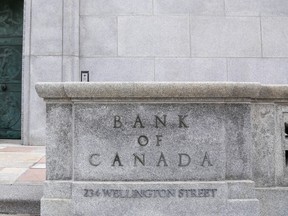Report into central bank’s actions taken during the pandemic highlights lessons learned
Article content
In a report following its review of actions taken in response to the pandemic, the Bank of Canada committed to using an exit condition for quantitative easing (QE) in the event it’s needed again, and to communicate more clearly the rationale behind the use of the program.
Article content
Article content
“The bank could use a QE exit condition more closely related to its monetary policy mandate and make this condition clear when introducing any future QE program,” the report said. “Ideally, the exit condition should be closely related to the outlook for inflation.”
Advertisement 2
Article content
Another lesson learned from the pandemic is to do a better job differentiating the purpose of its Government Bond Purchase Program. In March 2020, the central bank began the program to restore market function. In June 2020, the program’s purpose switched to provide monetary stimulus to the economy.
In October 2021, the bank ended its QE program, as the economic recovery was well underway. CPI stood at 4.4 per cent in September 2021 and would continue to climb into 2022. In the proceeding few months, the central bank would keep its balance sheet at the same level in what it called the “reinvestment phase.” In March 2022, the bank began to raise interest rates and started the process of quantitative tightening.
The Bank of Canada asked three outside experts to provide comments on its review: University of Calgary professor and economist Trevor Tombe, former Bank of Spain governor Pablo Hernández de Cos and former member of the Bank of England’s Monetary Policy Committee and Massachusetts Institute of Technology professor Kristin Forbes.
The experts questioned why the central bank did not consider moving interest rates below 0.25 per cent and into negative territory, as other central banks had done during the global financial crisis.
Article content
Advertisement 3
Article content
“Even if rates below 25 basis points have significant disadvantages, are there situations where negative rates would be a more effective means of providing stimulus than QE?” read the expert comments.
The experts also say questions remain on the consequences that followed the timing of the stimulus pullback.
“If the bank had provided less stimulus during the pandemic and/or started removing stimulus earlier, would that have meaningfully reduced the increases in interest rates that were subsequently required?” read the expert comments. “Or would it have simply allowed the bank to raise rates at a slower, more traditional pace?”
Even though fiscal and monetary policy are independent, the experts suggest there should be better information sharing with fiscal authorities to calibrate the extent of the stimulus required.
“Could this have reduced the amount of assets that were subsequently purchased?” read the expert comments. “It also would be helpful to more carefully evaluate the relationship between QE and fiscal policy in terms of the broader changes in the maturity structure of government debt.”
Advertisement 4
Article content
During the pandemic, the central bank also used Extraordinary Forward Guidance (EFG), which signalled the policy rate was going to remain at its effective lower bound of 0.25 per cent for an extended period of time.
In future, the central bank says it will make the EFG conditional on the outlook of inflation.
Recommended from Editorial
Following the larger-than-expect rise in inflation following the pandemic, the central bank also committed to improving its forecasting models.
“Bank models such as the Terms-of-Trade Economic Model include cost-based channels for inflation, but these models were underused during the pandemic,” the report said. “Bank staff are presently considering ways to include a wider range of plausible economic scenarios into the quarterly projection exercise.”
• Email: jgowling@postmedia.com
Bookmark our website and support our journalism: Don’t miss the business news you need to know — add financialpost.com to your bookmarks and sign up for our newsletters here.
Article content
Bank of Canada promises better quantitative easing communication
2025-01-17 18:38:27





